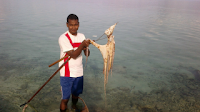Pacific Salmon
Five species of Pacific salmon thrive in the North Pacific waters of
the U.S. and Canada: chinook (also called king), coho, pink, sockeye,
and chum salmon. They begin their lives in freshwater streams, lakes,
and rivers and migrate to the sea as small fish called smolts. After
they transition from fresh to salt water and grow into adults in the
high seas of the North Pacific Ocean, a biological clock tells the
salmon when it's time to return to the place of their birth to spawn a
new generation. For the indigenous people of the Pacific Rim, salmon are
a primary source of protein and also a part of their culture. Native
groups celebrate the first return of salmon and individuals catch and
store salmon for their families to eat all winter.
Salmon play a major role in many economies. The North Pacific provides the primary source of wild salmon that is harvested commercially and eaten in homes and restaurants all over the world. The Alaska salmon fishery, responsible for around 90% of wild caught salmon in North America, is certified by the Marine Stewardship Council.
Salmon play a major role in many economies. The North Pacific provides the primary source of wild salmon that is harvested commercially and eaten in homes and restaurants all over the world. The Alaska salmon fishery, responsible for around 90% of wild caught salmon in North America, is certified by the Marine Stewardship Council.




Comments
Post a Comment